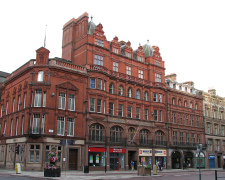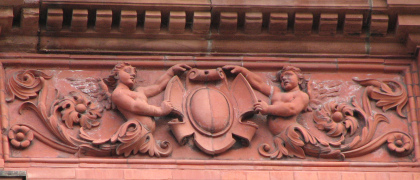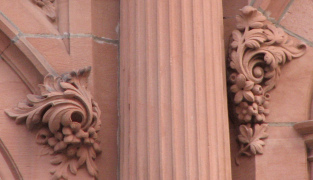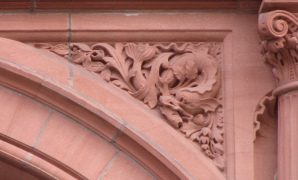 3-5 Castle St (centre) by Grayson, 1888-90.
3-5 Castle St (centre) by Grayson, 1888-90.
 3-5 Castle St (centre) by Grayson, 1888-90.
3-5 Castle St (centre) by Grayson, 1888-90.
Castle Street, one of Liverpool’s most historic streets, contains many splendid buildings, mostly of Victorian vintage, and among them one of the most lavishly decorated is the former British and Foreign Marine Insurance Company Building, nos. 3-5 Castle Street at the Old Town Hall end almost on the corner of Dale Street.
It is five bays wide at ground level, with more numerous windows higher up, with projecting bay windows higher up to the left and right ends, and a modest central portico with some slight emphasis given by a projection of the bay immediately above. Higher up – there are five storeys above the ground floor including the dormers – are a long balcony and pointy roofs.
Mosaic frieze in Salviati mosaic by Frank Murray.


The whole is in terra cotta and red brick, and with the lower buildings to left and right of the same materials, appears to be the central portion of a larger edifice. It is the work of Grayson, of the architectural partnership of Grayson and Ould (who were also responsible for the next building along, once the Queen Insurance Building), and was put up in 1888-1890.
The building decoration, which is what is of interest to these pages, includes moulded sculptural ornament in terra cotta, and, less usually, a mosaic frieze. This latter consists of three long, narrow panels above the first floor, and to left and right of these, triangular panels next to the bases of the projecting bay windows. The central panel shows the company name on a twisted ribbon, with the flags of Liverpool and England to left and right. The panels to left and right show shipping. That to the left shows two sailing ships and a grand ocean liner to the left, with a sunrise in the background; that to the right has three more ancient boats, including a galleon. All three panels have much gold mosaic in the background, to help light up the thin panels. The triangular panels, sort of upside down spandrels, as it were, contain dolphins in Roman style. The type of mosaic, with its varied and bright colours, can only be Venetian smalti, and given the date, we may reasonably ascribe them to the firm of Salviati (noted on the page on Victorian and Edwardian architectural mosaics in London). Happily, the designer of the pictures signs one of the larger panels; he is Frank Murray, and he made them in 1889. The setting of the mosaics is rather more English than Italian.
Terra cotta detail to the building


The terra cotta sculpture is nicely done and consists, as is often the case, of rather small embellishments so that the effect on such a large building is to give some vague impression of adornment and encrustation rather than individual sculptures which hold their own as additions to the building. The various arched windows however give rise to considerable opportunity for leafy spandrels (see this page for general introduction to spandrel sculpture), rather good corbels, birds, and to revert to the nautical theme appropriate for the building, fanciful fish, scallops, etc.
Castle Street // Liverpool's Queen Victoria Memorial // Other Liverpool sculpture
Statues in English towns // Sculpture pages
Visits to this page from 13 Mar 2014: 1,230 since 8 October 2024